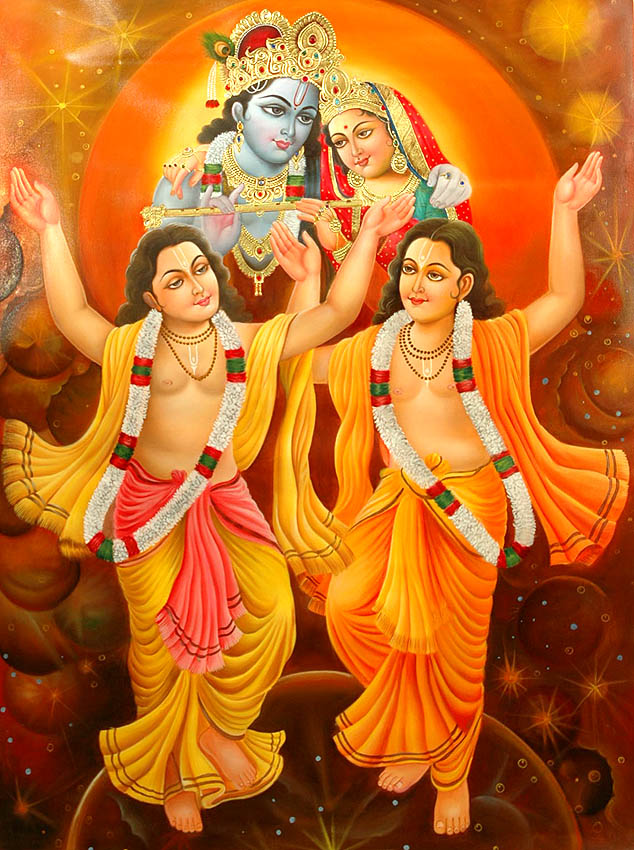Mahanidhi Madan Gopal Das
Srila Vrndavana dasa Thakura describes how Caitanya Mahaprabhu instituted the first Gaudiya Vaisnava Vyasa-puja ceremony in 1509 a.d. through Sri Nityananda Prabhu in Shrivasa Angana, Navadvipa.
“Srivasa Pandita, the head priest for the function, gave Prabhu Nityananda a flower garland to offer to a painting of Vyasadeva. Holding the garland in His beautiful lotus hand, Nityananda Prabhu hesitated and began glancing here and there as if He was looking for someone.
“Then to everyone’s surprise, Nityananda offered the garland to Sri Caitanyadeva instead. At that moment, Sri Caitanya immediately manifested His six-armed form, sad-bhuja, i.e. the combined visnu-tattva forms of Sri Krishna, Sri Rama, and Sri Caitanya).” (Caitanya Bhagavata (Madhya khanda chp. 5)
Thus, Sri Nityananda Prabhu completed the Vyasa-puja ceremony by offering a garland to that personality from whom everything emanates and whose empowered incarnation is Sri Vyasa-deva. By this Nityananda Prabhu established the real meaning of Vyasa-puja by worshiping the Bhagavan Sri Krishna Himself in the form of Sri Caitanya Mahaprabhu.
Sri Gauranga is the guru of Sri Nityananda Prabhu. This is the basis of the worship performed by Lord Nityananda. Therefore, the worship of Vyasa-deva, therefore, is actually the worship of Sri Gauranga in the form of the present acarya.
Although Sri Krishna and Sri Baladeva Prabhu are identical with Sri Caitanyadeva and Sri Nityananda Prabhu, Their activities are different. Nitai and Gaura are the supreme masters, para-tattva Bhagavans, yet they play the role of devotees. Gaur-Nitai act as devotees in order to teach all bhaktas the art of devotional service.
Thus, in this pastime from Caitanya Bhagavata, one Bhagavan, Nityananda Prabhu, is teaching us Gaudiya Vaisnavas that the ultimate recipient of the worship of Vyasa-deva or the spiritual master is Bhagavan Sri Krishna Caitanyadeva.
In the scriptures, Sri Krishna tells Uddhava that the acharya is the manifestation of Himself:
acharyam mam vijaniyan, navamanyeta karhicit
na martya-buddhy asuyeta, sarva-deva-mayo guruh
“One should know the acharya as Myself and never disrespect him in any way. One should not envy him, thinking him an ordinary man, for he is the representative of all the demigods.” (Srimad Bhagavatam 11.17.27)
If Sri Guru is not regarded as identical with Bhagavan, the worship of the acharya is not properly performed, and the said worshiper will not realize the true purport of the Vedas.
yasya deve para bhaktir, yatha deve tatha gurau
tasyaite kathita hy arthah, prakashshante mahatmana
For one who has unflinching faith in the lotus feet of the Sri Krishna, as well as in the spiritual master, the real import of Vedic knowledge can be revealed. (Shvetashvatara Upanishad 6.23)
Sri Guru is empowered by Sri Krishna to save the fallen souls from the clutches of Maya. As Sri Krishna’s delegated authority, the spiritual master liberates the conditioned souls from material world by engaging them in the direct service of Bhagavan Sri Krishna.
The story of Srila Raghunatha Dasa Gosvami’s repeated attempts to leave home and run to Jagannatha Puri to be with Sri Caitanya show the necessity of first receiving the mercy of Sri Guru and Sri Nityananda before one can attain the service of Bhagavan Sri Krishna Caitanyadeva.
Sri Guru ki jai! Jai Jai Sri Radhe!

